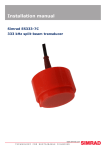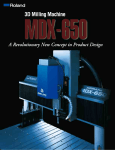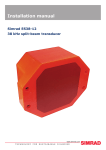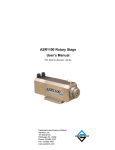Download Operating Instructions Centro P Collet Chucks
Transcript
Operating Instructions 13. How to solve possible faults? fault Operating Instructions Centro P Collet Chucks Cause elimination dirt/swarf in chuck body, clamping sleeve, clamping nut or at the tool shank cutting tool itself inaccurate, for example long drills unacceptable tool runout clean all parts ref. to item 3 and 5 very intensively ZB20005.GB 1H 102006 EF · Rev. A no coolant comes through the tool 1. Product features • tool shank is not clamped sufficiently, minimum 2/3 (at small Ø completely) of the clamping length of the collet tool shank to be inserted the whole length of the collet • • • • a worn or damaged collet in use always use new ER Collets with narrowed tolerance wrong seal is inserted – shank-Ø is smaller than the Ø to be sealed aggressive coolant tool is inserted with the cutting edge through the seal coolant bores in the chuck, stop screw or the coolant supply of the machine are impaired. extreme high system accuracy and repeatability (5m checked at the cutting tool at a distance of 3 x D, max. 50 mm) high clamping forces gripping of shanks with H10 tolerance without loss of accuracy tool shanks are axially clamped on the entire length, which leads to remarkable concentricity the extra long, double length guide between chuck body and clamping nut results in perfect stability with maximum compactness, which minimises bending and compression loads without compromising operating clearances. designed for HPC and conventional applications (for HPC applications we recommend the Mini nut versions as their construction reduces wind noise) for drilling, milling, tapping and reaming taps can be clamped in standard collets 2. Executions internal cone of the machine is worn or there is dirt/swarf automatic tool changer is not aligned to the machine spindle • • • bearing problem in the machine coolant is spouting through the clamping sleeve Please pay attention to the fact that Centro P is a precision collet chuck system, and constructed to clamp nominal diameters only, in order to achieve highest possible system accuracy and optimum stability! check tool ref. to item 5 bearing in the pre-setter or in the accuracy check machine is not o.k. unacceptable tool runout after automatic tool change Operating Instructions Centro P is available in different executions: SK, HSK, MAS/BT, CAT and on customers request. clamp chuck by hand to check replace seal for correct size replace seal for new one replace seal if damaged and reposition tool clean the coolant bores with a cleaning medium (not acidic, because of the rust) 3. General hints and cleanliness for use of a Centro P Collet Chuck In order to guarantee the system accuracy of 5m, we highly recommend the use of ER Collets with narrowed tolerance, since they are perfectly matched to Centro P. The Collets are produced to DIN6499/ISO15488. To maintain system accuracy and in order not to damage the sliding surfaces of the clamping nut the cylindrical double guides before and after the thread, and the thread itself must be free of swarf and dirt. The clamping nuts are available in two versions: • Version without seal – the collet face is flush to the face of the clamping nut, i.e. the cutting tool can be clamped shorter and is therefore more stable • Version with seal – for inner coolant supply as well as to avoid entry of dirt and swarf into the chuck. The clamping nut and the seals must be checked before inserting and must be cleaned if necessary. 4. Design Sales by: FRANKEN GmbH & Co. KG Fabrik für Präzisionswerkzeuge Frankenstraße 7/9a DE-90607 Rückersdorf Telephone Facsimile E-Mail Internet October 2006 Page 4 +49/911/9575-5 +49/911/9575-327 [email protected] www.emuge-franken.de www.frankentechnik.de Page 1 Operating Instructions Operating Instructions 5. Tool check 8. Clamping of the cutting tool Inspect and clean the tool shank to be clamped. Check the accuracy from the shank to the cutting edge (this can be done for example in a vee block). Clamping is made by either a hook wrench DIN1810-B with pin for standard nuts or special wrench for the mini nuts. For the standard nuts, sizes ER16 as well as size ER32 we recommend to use a torque setting wrench with the respective heads for clamping, especially for milling in order to get the optimum clamping forces. The maximum clamping torque is also mentioned on the clamping nut. 6. Tool length pre-setting Tool length pre-setting is possible from the front as well as from the rear through the chuck body. In order to clamp the cutting tool in the optimum position (i.e. as short as possible, but as long as necessary), we offer three types of adjustable stops: • form U, for long tool shanks that go through the collet into the collet chuck, • form W, when the tool shank ends in the collet. This is particularly the case with small diameters (note: minimum 2/3 of the clamping length of the collet should be clamped) and • form R is a blank, which can be adapted to the diameter of the collet. The diameter of the adjustable stop must be minimum 0,5 mm smaller than the nominal diameter of the collet, in order to ensure that the collet clamps only the shank of the cutting tool. Schedule of the torque moments for clamping the chucks max. clamping type wrenches torque ER16M 28Nm 6681.16M heads for torque setting wrenches ER16 50Nm 6681.16 6692.10 ER32 105Nm 6681.32 6692.20 7. Clamping of the cutting tool • • If necessary, insert the fitting seal (the vulcanised side must locate against the collet face). Press the collet axially into the clamping nut until the collet head clips into the extraction groove (note: no eccentric). 9. Changing of the collet When loosening the clamping nut the collet is extracted out of the chuck body. Having removed the cutting tool from the collet, lateral pressure the collet leaves will aid removal from the clamping nut. In order not to damage the collet we highly recommend the use of our collet extractor, with which the collet can be removed safely and easily from the clamping nut. Attention: Before repeated insertion and clamping of a collet please make reference to items 3 and 5 and use only ER Collets with narrowed tolerance. 10. Changing of the cutting tool • • • Insert the cutting tool into the collet. Length pre-setting from the front with screw driver/socket wrench. Screw on the clamping nut by hand loose on the chuck body. It must be ensured that there is no swarf or dirt on the surfaces of the collet, which could negatively influence the system accuracy and damage the collet. When changing the cutting tool, the clamping nut and the collet should be removed from the chuck body and cleaned thoroughly. 11. Maintenance A special maintenance additional to normal cleaning processes is not necessary. 12. Safety Be aware of the safety instructions of the machine or other tools used! Never work with open machine door, especially at high speed or when using HSK tapers. Collisions at high speed could result in breakage of the cutting tool or collet chuck causing serious injury. • • Insert the cutting tool till it backstops. Alternatively length pre-setting from the rear with T-handle hex wrenches. Page 2 Page 3 Operating Instructions Operating Instructions 5. Tool check 8. Clamping of the cutting tool Inspect and clean the tool shank to be clamped. Check the accuracy from the shank to the cutting edge (this can be done for example in a vee block). Clamping is made by either a hook wrench DIN1810-B with pin for standard nuts or special wrench for the mini nuts. For the standard nuts, sizes ER16 as well as size ER32 we recommend to use a torque setting wrench with the respective heads for clamping, especially for milling in order to get the optimum clamping forces. The maximum clamping torque is also mentioned on the clamping nut. 6. Tool length pre-setting Tool length pre-setting is possible from the front as well as from the rear through the chuck body. In order to clamp the cutting tool in the optimum position (i.e. as short as possible, but as long as necessary), we offer three types of adjustable stops: • form U, for long tool shanks that go through the collet into the collet chuck, • form W, when the tool shank ends in the collet. This is particularly the case with small diameters (note: minimum 2/3 of the clamping length of the collet should be clamped) and • form R is a blank, which can be adapted to the diameter of the collet. The diameter of the adjustable stop must be minimum 0,5 mm smaller than the nominal diameter of the collet, in order to ensure that the collet clamps only the shank of the cutting tool. Schedule of the torque moments for clamping the chucks max. clamping type wrenches torque ER16M 28Nm 6681.16M heads for torque setting wrenches ER16 50Nm 6681.16 6692.10 ER32 105Nm 6681.32 6692.20 7. Clamping of the cutting tool • • If necessary, insert the fitting seal (the vulcanised side must locate against the collet face). Press the collet axially into the clamping nut until the collet head clips into the extraction groove (note: no eccentric). 9. Changing of the collet When loosening the clamping nut the collet is extracted out of the chuck body. Having removed the cutting tool from the collet, lateral pressure the collet leaves will aid removal from the clamping nut. In order not to damage the collet we highly recommend the use of our collet extractor, with which the collet can be removed safely and easily from the clamping nut. Attention: Before repeated insertion and clamping of a collet please make reference to items 3 and 5 and use only ER Collets with narrowed tolerance. 10. Changing of the cutting tool • • • Insert the cutting tool into the collet. Length pre-setting from the front with screw driver/socket wrench. Screw on the clamping nut by hand loose on the chuck body. It must be ensured that there is no swarf or dirt on the surfaces of the collet, which could negatively influence the system accuracy and damage the collet. When changing the cutting tool, the clamping nut and the collet should be removed from the chuck body and cleaned thoroughly. 11. Maintenance A special maintenance additional to normal cleaning processes is not necessary. 12. Safety Be aware of the safety instructions of the machine or other tools used! Never work with open machine door, especially at high speed or when using HSK tapers. Collisions at high speed could result in breakage of the cutting tool or collet chuck causing serious injury. • • Insert the cutting tool till it backstops. Alternatively length pre-setting from the rear with T-handle hex wrenches. Page 2 Page 3 Operating Instructions 13. How to solve possible faults? fault Operating Instructions Centro P Collet Chucks Cause elimination dirt/swarf in chuck body, clamping sleeve, clamping nut or at the tool shank cutting tool itself inaccurate, for example long drills unacceptable tool runout clean all parts ref. to item 3 and 5 very intensively ZB20005.GB 1H 102006 EF · Rev. A no coolant comes through the tool 1. Product features • tool shank is not clamped sufficiently, minimum 2/3 (at small Ø completely) of the clamping length of the collet tool shank to be inserted the whole length of the collet • • • • a worn or damaged collet in use always use new ER Collets with narrowed tolerance wrong seal is inserted – shank-Ø is smaller than the Ø to be sealed aggressive coolant tool is inserted with the cutting edge through the seal coolant bores in the chuck, stop screw or the coolant supply of the machine are impaired. extreme high system accuracy and repeatability (5m checked at the cutting tool at a distance of 3 x D, max. 50 mm) high clamping forces gripping of shanks with H10 tolerance without loss of accuracy tool shanks are axially clamped on the entire length, which leads to remarkable concentricity the extra long, double length guide between chuck body and clamping nut results in perfect stability with maximum compactness, which minimises bending and compression loads without compromising operating clearances. designed for HPC and conventional applications (for HPC applications we recommend the Mini nut versions as their construction reduces wind noise) for drilling, milling, tapping and reaming taps can be clamped in standard collets 2. Executions internal cone of the machine is worn or there is dirt/swarf automatic tool changer is not aligned to the machine spindle • • • bearing problem in the machine coolant is spouting through the clamping sleeve Please pay attention to the fact that Centro P is a precision collet chuck system, and constructed to clamp nominal diameters only, in order to achieve highest possible system accuracy and optimum stability! check tool ref. to item 5 bearing in the pre-setter or in the accuracy check machine is not o.k. unacceptable tool runout after automatic tool change Operating Instructions Centro P is available in different executions: SK, HSK, MAS/BT, CAT and on customers request. clamp chuck by hand to check replace seal for correct size replace seal for new one replace seal if damaged and reposition tool clean the coolant bores with a cleaning medium (not acidic, because of the rust) 3. General hints and cleanliness for use of a Centro P Collet Chuck In order to guarantee the system accuracy of 5m, we highly recommend the use of ER Collets with narrowed tolerance, since they are perfectly matched to Centro P. The Collets are produced to DIN6499/ISO15488. To maintain system accuracy and in order not to damage the sliding surfaces of the clamping nut the cylindrical double guides before and after the thread, and the thread itself must be free of swarf and dirt. The clamping nuts are available in two versions: • Version without seal – the collet face is flush to the face of the clamping nut, i.e. the cutting tool can be clamped shorter and is therefore more stable • Version with seal – for inner coolant supply as well as to avoid entry of dirt and swarf into the chuck. The clamping nut and the seals must be checked before inserting and must be cleaned if necessary. 4. Design Sales by: FRANKEN GmbH & Co. KG Fabrik für Präzisionswerkzeuge Frankenstraße 7/9a DE-90607 Rückersdorf Telephone Facsimile E-Mail Internet October 2006 Page 4 +49/911/9575-5 +49/911/9575-327 [email protected] www.emuge-franken.de www.frankentechnik.de Page 1






